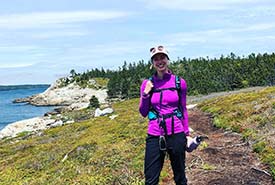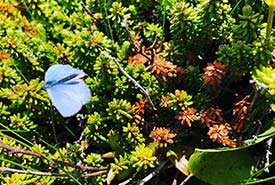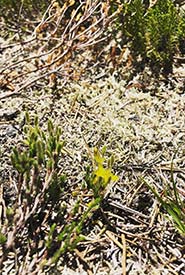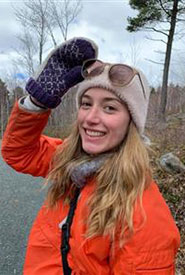Introduction to NCC and field work

Samantha Stegen at Prospect, NS (Photo by NCC)
Since a young age, I have had a deep appreciation for nature, leading me to complete a bachelor of science degree in environmental science at Acadia University in 2020 and begin my master’s of resource and environmental management at Dalhousie University.
In previous professional work, I have studied agricultural entomology (the study of insects of interest to agriculture) in the Annapolis Valley, Nova Scotia. I am curious to learn more about the native flora and fauna of Nova Scotia, and serving as a conservation intern for the Nature Conservancy of Canada (NCC) feels like a perfect fit.

A butterfly that I encountered during fieldwork (Photo by NCC)
To me, conservation means protecting and conserving nature for future generations. My biggest takeaway from previous field work experiences is to lead with safety, fun and respect for people and the environment. This summer, I am most looking forward to travelling to NCC properties, monitoring species and classifying ecosystem types. I am also interested in strengthening my abilities with geo-referencing of spatial data (taking and transforming data into digestible information, such as reports and maps). This information, such as ecosystem types, species sightings and human-made structure locations, is stored in NCC’s database. New data is added after each property visit, this way, our conservation team can make a plan to protect the area accordingly. My work with NCC involves using the Land Information System software and ArcGIS. Already, I am feeling more confident with managing data, maps and other geospatial material.
After my internship with NCC, I hope to carry the knowledge gained from this experience to further educate others and work to develop my career in environmental stewardship, perhaps through a PhD program or work opportunity in Canada or abroad.

Pine barren goldenheather (Photo by NCC)
This week was my first week working in the field because of the pandemic. The past weeks working from home only intensified my eagerness to begin field work. And, wow, the places where I get to conduct field work are special because they are filled with biodiversity. It becomes evident when we are able to identify many ecosystem types within one property. The closer I looked, the more I found: mosses, lichens, ants, birds and aphids, they're all working together. Two beautiful days of learning in the green space — my trusty team and I went to the Shaw Wilderness Park and then to the Dr. Bill Freedman Nature Reserve. My colleagues were very helpful and knowledgeable, I learned many new species of plants, birds, butterflies and bugs. I added pine barren goldenheather, crowberry, juniper, Labrador tea and common yellow-throated warbler to my list of visually identifiable species.
Some of the equipment we needed in the field included a GPS, ArcGIS Field Map app for uploading data immediately and the forest ecosystem classification guidebook. Other materials were sunscreen, bug spray, hiking boots and lots of water! We hiked approximately 10 kilometres each day. I felt very prepared for the field because of my previous field work experience and because I was well-informed about the property in advance.
A 10/10 week! Thank you NCC for this amazing experience to lead as a conservation intern for the province of Nova Scotia. It is truly a dream come true.


